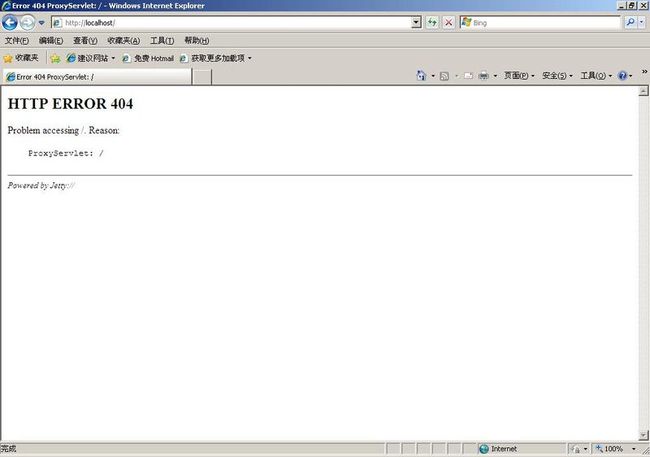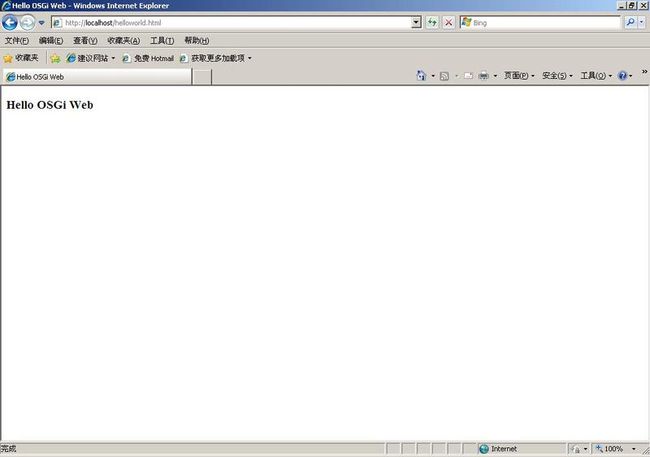OSGi 环境下的 Web 开发(一):使用 Equinox 框架
关于 OSGi(Open Service Gateway Initiative) 相关理论知识网上有许多文档,这里就不作介绍了,有兴趣的可以自行查阅(文后附有相关的链接)。
OSGi 容器与 J2EE 容器整合主要有两种方式:1、将 HTTP Server 置于 Equinox 框架中;2、将 Equinox 置于 Servlet 容器中,这里使用第1种方式。
一、环境搭建:
1、预备环境
JDK(本文使用Sun JDK 5)
Eclipse(本文使用版本为 Eclipse3.5.2,这里的eclipse不是作为开发工具,而仅是使用其 plugin)
2、建立如下目录结构:
3、从 Eclipse/Plugins 下拷贝如下 jar 至 DEMO 目录下:
4、config.ini 的内容如下:
osgi.bundles 定义的是OSGi容器启动时,需自启动的 Bundle,其 Bundle 状态为 ACTIVE (如果启动时没有异常)。
5、启动 OSGi
进入命令行,在DEMO目录下键入
java -jar org.eclipse.osgi_3.5.2.R35x_v20100126.jar -console
如能见到 osgi> 则表示容器启动成功。
键入 ss 可查看各 bundle 的状态。
在浏览器中访问 http://localhost/ ,能见到如下页面,则表示 jetty 容器也已成功启动。

如果未成功启动,可键入 start [bundle-id] 重新启动,根据抛出的异常来定位问题。
二、开发 web 应用
这里的 web 应用与J2EE中的不一样的,J2EE中的web应用主要是以 war 形式提供的,而在OSGi环境中,则是以jar提供的,即 bundle,也即 eclipse 中的一个插件(plug-in)。
1、org.osgidemo.web.jar 的目录结构如下:
2、MANIFEST.MF 内容如下:
3、plugin.xml 内容如下:
在 plugin.xml 文件中,定义了一个扩展,用来处理对静态资源文件例如图片文件等的请求。
4、hello.html 就是web应用的资源,其内容为:
三、安装 web 应用
将 org.osgidemo.web.jar 拷贝至 DEMO 目录下,在 osgi 命令提示符下,键入
install reference:file:org.osgidemo.web.jar
命令会返回 Bundle id is [id],这里的 id 是 bundle 唯一编号,这时 bundle 的状态为 INSTALLED,再键入:
start [id]
启动该 bundle 。
四、在浏览器中,访问 http://localhost/hello.html,见到如下画面:

则表明 web 应用已经安装成功,并能成功处理http请求。
如要停止应用
stop [bundle-id]
卸载应用
uninstall [bundle-id]
基于此,web 应用的真正热插拨、热部署成为可能。
五、参考文档
http://www.iteye.com/wiki/OSGi
http://www.ibm.com/developerworks/cn/web/0907_osgiweb_liuqing
http://baike.baidu.com/view/362847.htm?fr=ala0_1_1
OSGi 容器与 J2EE 容器整合主要有两种方式:1、将 HTTP Server 置于 Equinox 框架中;2、将 Equinox 置于 Servlet 容器中,这里使用第1种方式。
一、环境搭建:
1、预备环境
JDK(本文使用Sun JDK 5)
Eclipse(本文使用版本为 Eclipse3.5.2,这里的eclipse不是作为开发工具,而仅是使用其 plugin)
2、建立如下目录结构:
DEMO
|- configuration
- config.ini
|- [Bundle.jar]
3、从 Eclipse/Plugins 下拷贝如下 jar 至 DEMO 目录下:
javax.servlet_2.5.0.v200806031605.jar org.apache.commons.logging_1.0.4.v200904062259.jar org.eclipse.equinox.common_3.5.1.R35x_v20090807-1100.jar org.eclipse.equinox.http.jetty_2.0.0.v20090520-1800.jar org.eclipse.equinox.http.registry_1.0.200.v20090520-1800.jar org.eclipse.equinox.http.servlet_1.0.200.v20090520-1800.jar org.eclipse.equinox.registry_3.4.100.v20090520-1800.jar org.eclipse.osgi.services_3.2.0.v20090520-1800.jar org.eclipse.osgi_3.5.2.R35x_v20100126.jar org.mortbay.jetty.server_6.1.15.v200905151201.jar org.mortbay.jetty.util_6.1.15.v200905182336.jar
4、config.ini 的内容如下:
osgi.bundles=reference\:file\:org.eclipse.equinox.registry_3.4.100.v20090520-1800.jar@start,reference\:file\:org.eclipse.equinox.common_3.5.1.R35x_v20090807- 1100.jar@start,reference\:file\:org.mortbay.jetty.util_6.1.15.v200905182336.jar@start,reference\:file\:org.mortbay.jetty.server_6.1.15.v200905151201.jar@start,reference\:file\:org.eclipse.equinox.http.registry_1.0.200.v20090520-1800.jar@start,reference\:file\:org.eclipse.equinox.http.jetty_2.0.0.v20090520-1800.jar@start,reference\:file\:org.apache.commons.logging_1.0.4.v200904062259.jar@start,reference\:file\:org.eclipse.osgi.services_3.2.0.v20090520-1800.jar@start,reference\:file\:org.eclipse.equinox.http.servlet_1.0.200.v20090520-1800.jar@start,reference\:file\:javax.servlet_2.5.0.v200806031605.jar@start
osgi.bundles 定义的是OSGi容器启动时,需自启动的 Bundle,其 Bundle 状态为 ACTIVE (如果启动时没有异常)。
5、启动 OSGi
进入命令行,在DEMO目录下键入
java -jar org.eclipse.osgi_3.5.2.R35x_v20100126.jar -console
如能见到 osgi> 则表示容器启动成功。
键入 ss 可查看各 bundle 的状态。
在浏览器中访问 http://localhost/ ,能见到如下页面,则表示 jetty 容器也已成功启动。

如果未成功启动,可键入 start [bundle-id] 重新启动,根据抛出的异常来定位问题。
二、开发 web 应用
这里的 web 应用与J2EE中的不一样的,J2EE中的web应用主要是以 war 形式提供的,而在OSGi环境中,则是以jar提供的,即 bundle,也即 eclipse 中的一个插件(plug-in)。
1、org.osgidemo.web.jar 的目录结构如下:
org.osgidemo.web.jar
|- META-INF
MANIFEST.MF
|- plugin.xml
|- hello.html
2、MANIFEST.MF 内容如下:
Manifest-Version: 1.0 Require-Bundle: org.eclipse.equinox.http.registry Bundle-ActivationPolicy: lazy Bundle-Version: 1.0.0.201005232055 Bundle-Name: org.osgidemo.web Bundle-ManifestVersion: 2 Import-Package: org.osgi.framework;version="1.3.0" Bundle-SymbolicName: org.osgidemo.web;singleton:=true Bundle-RequiredExecutionEnvironment: J2SE-1.5
3、plugin.xml 内容如下:
<?xml version="1.0" encoding="UTF-8"?>
<?eclipse version="3.4"?>
<plugin>
<extension id="helloResource" point="org.eclipse.equinox.http.registry.resources">
<resource alias="/hello.html" base-name="/hello.html" />
</extension>
</plugin>
在 plugin.xml 文件中,定义了一个扩展,用来处理对静态资源文件例如图片文件等的请求。
4、hello.html 就是web应用的资源,其内容为:
<!DOCTYPE html PUBLIC "-//W3C//DTD HTML 4.01 Transitional//EN" "http://www.w3.org/TR/html4/loose.dtd"> <html> <head> <meta http-equiv="Content-Type" content="text/html; charset=ISO-8859-1"> <title>Hello OSGi Web</title> </head> <body> <h3>Hello OSGi Web</h3> </body> </html>
三、安装 web 应用
将 org.osgidemo.web.jar 拷贝至 DEMO 目录下,在 osgi 命令提示符下,键入
install reference:file:org.osgidemo.web.jar
命令会返回 Bundle id is [id],这里的 id 是 bundle 唯一编号,这时 bundle 的状态为 INSTALLED,再键入:
start [id]
启动该 bundle 。
四、在浏览器中,访问 http://localhost/hello.html,见到如下画面:

则表明 web 应用已经安装成功,并能成功处理http请求。
如要停止应用
stop [bundle-id]
卸载应用
uninstall [bundle-id]
基于此,web 应用的真正热插拨、热部署成为可能。
五、参考文档
http://www.iteye.com/wiki/OSGi
http://www.ibm.com/developerworks/cn/web/0907_osgiweb_liuqing
http://baike.baidu.com/view/362847.htm?fr=ala0_1_1